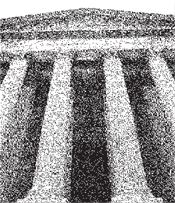For almost all professionals, quantum computing is background noise in their social media feed, occasionally rising to the level of awareness through far-reaching assertions about environmental salvation: “Quantum Computing Just Might Save the Planet” and “Quantum Computing Could Change the Way the World Uses Energy,” or even “Quantum Computing Will Be Bigger Than the Discovery of Fire!” Does any of this sound familiar? Just two years ago alternative meats were touted as a path to a future free of global-warming bovines and nutrient-polluting hogs—then the market collapsed. Or why hasn’t nanotechnology, first examined in this magazine almost twenty years ago, produced emissions-free manufacturing while eliminating resource inefficiency and waste.
It is not just flying cars and household robots that have failed to materialize, but hosts of other more mundane technologies with over-hyped promises. So should we pay attention this time? Quantum computing could hold the key to a new generation of high- performance, low-environmental impact batteries; efficient carbon capture technologies; or new ways to manufacture critical chemicals with far less energy. Separating uncritical, unbridled enthusiasm from realistic expectations is difficult at early stages of technology development and, as some observers have noted about today’s debates, “Hyperbolic expectations of future promise and potential have become more significant and intense.”
For the curious and quantum newbies, part of the challenge is being confronted with an impenetrable vocabulary—words like qubits, entanglement, superposition, and decoherence—and also a theory that has led scientists like Nobel physicist Richard Feynman to say, “Quantum mechanics describes nature as absurd from the point of view of common sense.”
Indeed, quantum computing has been a member of that club of fascinating technologies that always seem 20 or 30 years away, like nuclear fusion. But then in 2019, Google claimed that it had solved a problem in just 200 seconds that would have taken even the best classical supercomputer 10,000 years to complete—a feat termed quantum supremacy—later changed to quantum advantage after a number of scientists sent a letter to the journal Nature protesting the term “supremacy.” IBM quickly responded that the problem could be solved with an improved classical supercomputer technique in just 2.5 days, taking the sheen off of Google’s claim. And so it goes.
For the environmental community, the nagging questions around quantum computing, as with other emerging technologies, are: “Can the tech deliver more environmental upsides than downsides and, if so, in what time frame and at what cost?” At a minimum, quantum computing will need to prove it can live with less energy and produce less end-of-life waste, while reducing demands on scarce resources when compared with alternative computing systems.
Before we take on the question of whether it can produce the numerous claimed benefits—from better car batteries to more efficient fertilizers—we need to untangle what it is, or isn’t. For the last half century, computing has been built on bits, 0s or 1s; think of a golf ball with two dimples on opposing sides. A quantum bit, or qubit for short, can be in multiple states at once. Now think of a golf ball with hundreds of dimples—the number of possible connections goes up exponentially. This ability to simultaneously be in multiple states is called superposition. It allows a quantum computer to crunch through large numbers of possible outcomes simultaneously. Now imagine that these qubits are linked (in qu-speak this is what is meant by entanglement) so they can exchange information. That is the good news. But this state is extremely fragile and can be sustained only if the qubits are effectively isolated from their environment, for instance, by cooling them down to near absolute zero in a vacuum chambers. Otherwise, the qubits decay and ultimately disappear, and that is what is called decoherence. Because of this challenge, errors creep into the calculations and must be corrected, most often through the use of more qubits. It can take thousands of error-correcting qubits to create one highly accurate logical qubit. As Michael Beircuk, who runs the Quantum Control Lab at the University of Sydney, has noted, quantum error correction “is the single biggest problem holding back quantum computing from realizing its great promise.”
A fully error-corrected, general-purpose quantum computer may be many years away. In the meantime (probably in the next five to fifteen years) there are two options. First, what are known as digital noisy intermediate-scale quantum computers, which rely on error correction to improve performance and accuracy. Second, analog quantum computers, which simulate the dynamics of quantum-mechanical systems, for instance, describing the behavior of electrons in materials or in large molecules—nature at its most fundamental levels. Even a few error-corrected qubits can accomplish a lot. One early use of a modest 2-5 qubit quantum simulator back in 2015 was the prediction of extreme drought conditions for a number of cities, including Brussels, Bratislava, and Sofia. Today’s quantum computers have reached beyond 400 logical qubits and projections to over 1,000 qubits in the next two years or so are now common.
It is important to emphasize that a hardware solution is not enough—quantum computers require quantum algorithms to function. Over 15 years ago, an article on quantum computing in Scientific American presciently noted that, “Quantum computers would suffer from many of the same algorithmic limitations as today’s classical computers.” Dave Bacon, former leader of the Google software effort in this area, stressed that “quantum code . . . has to be highly tailored to the qubits it will run on. That means the code for IBM’s chips won’t run on those of other companies.” The key to remember is that successful quantum computing depends on both hardware and software advances.
So is this a big deal? There are plenty of skeptics. One recent article noted that quantum computing is “newsful, but maybe not yet useful.” But that is often the fate of novel technologies. Viewed through the broader lens of history, observers of technology may see quantum computing as a discontinuous break—a change driven by innovations that radically improve the state-of-the-art over earlier microchips and their forerunner, vacuum tubes. Quantum computing arrives on the technological stage at a time when recent research shows slowing rates of disruptive advances, as measured by both patents and publications, and declining research productivity across multiple sectors and technology classes. Given the nature of our global environmental challenges, we need some game changers.
If quantum computing represents a true disruption, it should change industry structures, shifting the locus of innovation as new firms gain market share over legacy organizations often constrained by tradition, sunk costs, and internal inflexibility. In fact, new business formation now extends far beyond the large, established players in the quantum computing space like Google, Microsoft, Honeywell, and IBM. Startups have raised significant funding, over $1 billion in venture funds globally in 2021, allowing a number of pure-play firms, such as D-Wave and IonQ, to go public. According to Tracxn, a private technology tracking and analysis company, as of September 2022, there were 89 quantum computing startups in the United States alone. Many of these firms have advanced beyond series A venture funding, reducing the chances of business failure.
There are also increases in government funding. The new CHIPS and Science Act passed by Congress last year contains $153 million (most to be spent between 2023 and 2027) to support quantum computing efforts, including funding for a Next Generation Quantum Leaders Pilot program. The European Quantum Flagship program is providing one billion euros to support quantum computing research over a 10-year period. Back in 2017, China started construction of a multi-node quantum science research laboratory. “We predict by 2027 over $16.4 billion will be invested into quantum computing,” says Heather West, a research manager at IDC, a global market intelligence firm. Combined public and private-sector activities are driving the demand for researchers and engineers in firms, government labs, and universities and demand could outstrip supply. The QED-C directory, which contains job listings in the field, now has almost 450 openings.
All this sounds encouraging. But it is important to keep in mind that a significant amount of quantum computing effort is not focused on developing planet-saving applications, but on providing protection against the possibility that quantum computers could render historical (and future) encryption systems ineffective. We should also remember that the large and well-funded classical computing ecosystem will not sit still while the quantum folks try to get their systems to work. One can expect improvements in the speed, capacity, and costs of classical supercomputing, as well as its underlying algorithms. This combination could challenge quantum advantage, which puts a premium on identifying practical challenges that only a quantum computer can solve. A recent Forbes article on possible business risks of investing in quantum computing emphasized this point, namely, the need to find “use cases that matter and actually need quantum computing [italics mine].”
Nevertheless, there are increasing hints that quantum computing could provide environmentally relevant solutions, for instance, in developing novel materials for catalysts, batteries, photovoltaics, or carbon capture. When Richard Feynman talked about quantum computer applications in the early 1980s, he emphasized that “there is to be an exact simulation, that the computer will do exactly the same as nature.” Quantum computing was recently used by researchers at Notre Dame and Kyung Hee universities to develop a transparent window coating that could lower energy consumption by one third over traditional air conditioning. Microsoft has demonstrated how quantum computers can help manufacture fertilizers with better yields by improving the catalytic processes. Mercedes Benz is working with PsiQuantum to develop new electrolytes for lithium-ion batteries for electric cars. The goals are to improve battery energy density, charging speed, life, range, cost, and safety. Robert Bosch GmbH is using IBM quantum computers to accelerate research into substitutes for scare metals for electric motors and fuel cells, with the hope of reducing the global demand for materials such as nickel, copper, lithium, and rare-earth elements.
Additional applications could help tackle the complex optimizations associated with areas like transportation logistics and routing as well as energy grid management. Volkswagen demonstrated the first real-time traffic-routing system to rely on quantum computing and tested the approach in Lisbon, Portugal. This system used both classical computing to analyze anonymized movement data combined with optimization using a quantum algorithm running on a D-Wave quantum computer. These early use cases are critical to long-term success. Beside reducing risks for first movers, a wide range of proof-of-concept trials across different technology platforms, with different algorithms, and various end-use cases, creates a rich experimentation space for hypothesis testing and learning.
But will advances come in time? Given the extent and urgency of climate problems, solutions need to be taken to scale quickly—a process that often requires navigating regulatory barriers and then achieving market penetration domestically and internationally. These challenges are often overlooked by scientists and technology developers. For instance, novel fertilizers can take three to ten years to wind their way through the regulatory approval process in the United States, which involves both federal and state regulations. Even when approved, new fertilizers would face market hurdles dependent on their acceptance by retailers and, ultimately, farmers, The eventual scale needed to provide environmental and food security benefits is large (the world requires around 180 million tons of ammonia-based fertilizers annually to feed half of the current population). Or take electric vehicles and the hurdles they face. Any novel battery integrated into a commercial product like an automobile will have to past stringent tests involving a variety of national and international organizations such as Underwriters Lab, the Society of Manufacturing Engineers, the International Organization for Standardization (ISO), or the new EU Battery Regulations.
Quantum computing faces multiple growing pains: first developing quantum computing itself, then applying it to solve important problems, and finally scaling the resulting solutions globally. A recent International Energy Agency report on “Reaching Net Zero by 2050” emphasized that achieving this goal will require not only further rapid deployment of available technologies, but also the “widespread use of technologies that are not on the market yet.” The agency said that “in 2050, almost half the reductions come from technologies that are currently at the demonstration or prototype phase.” Quantum computing is in this class of technologies under development that will probably have their full impact in the time span of 2035 to 2050. That is the same time frame as the global need to achieve net-zero carbon emission.
In the intermediate timeframe, it will be important to ensure that the ongoing deployment of quantum computing does not exacerbate natural burdens. One obvious question for environmentalists is whether quantum computing will affect the material and resource requirements of our computational infrastructure as well as associated end-of-life impacts. The production of microchips came with significant environmental costs, resulting in 23 Superfund sites in Silicon Valley alone, most contaminated with trichloroethylene, a solvent used in the early production of semiconductors. At the tail end of the life cycle there continue to be concerns about tons of computers piling up globally with little or no recycling, recovery, or reuse strategies. So-called e-waste amounts to over 53 million metric tons annually. Recycling rates are generally below 20 percent.
In contrast to the semiconductor industry, where a dominant material (silicon) and associated process technologies were locked in early, there are multiple and competing materials and technologies for quantum computing. Some approaches to achieving a quantum state make use of silicon, but a variety of other materials are being explored, including diamonds. Recently, researchers explored cuprous oxide found in a gemstone from Namibia as a platform for quantum simulators. Beyond the materials for quantum processors, there are materials linked to creating and maintaining the operating environment for quantum calculations to occur. For instance, cryogenic cooling systems often use liquid helium, which is becoming increasingly costly as the global supply dwindles.
Part of the total energy impacts are likely to be related to the energy needed to achieve and maintain a quantum state. To date, there are few comparative analyses of the operating energy required by various quantum computing platforms. A study done by the National Renewable Energy Lab provided some rough quantification and showed that the energy required for cooling is significantly larger than that required for computation, a reversal from energy usage patterns seen in conventional computing.
The largest positive impact may be related to energy use avoided if quantum computing reduces the need for more energy-intensive classical computing resources—what has been termed an energy quantum advantage. Some initial research involved the energy used to solve a problem (called the random quantum circuits problem) using supercomputers at NASA’s Ames Research Center and the Summit Supercomputer at Oak Ridge National Lab, compared with a quantum computer at Google. The problem required 21 to 97 megawatt-hours to run on the supercomputers versus .00042 megawatt-hours on the quantum computer. This is an impressive gain—five orders of magnitude—but provides one data point that was not run on a practical use case. Google claims that the Sycamore quantum processor consumes 26 kilowatts of electrical power, far less than a supercomputer (and around the power consumption of an average U.S. house).
Environmentalists interested in quantum computing face a set of decision points: if, when, and how to engage. Though the quantum computing ecosystem is in flux and the evolution of the technology is fraught with uncertainties, time still matters. As writer Bill McKibben has pointed out, “We’re running out of options and we’re running out of decades.” Understanding the pace of change of the technologies and the actors in the innovation system will define strategies, for instance by shaping or adapting, and impact actions, such as placing big bets or creating options and no-regrets moves versus a watch-and-wait strategy. It will make the difference between getting in front of issues or falling behind.
Regarding energy and resource use, it is not too early to begin thinking about how to quantify the impacts of the emerging quantum infrastructure, how to develop harmonized metrics, encourage data sharing, and heighten awareness within the field of the energy and broader sustainability impacts. The preponderance of competing technologies will make estimates difficult in the near term. But measurement techniques and metrics need to be explored, including the relevance and applicability of existing energy and environmental metrics, which cover areas like cooling, energy efficiency, resource use, and carbon footprint. Some efforts are underway. For instance, DARPA, the Defense Department’s independent R&D arm, has launched a program designed to “develop quantum computing yardsticks that can accurately measure what’s important to focus on in the race toward large, fault-tolerant quantum computers.” Quantum researchers in both academia and industry should be integrated into on-going efforts to promote what is now termed sustainable computing, a subset of a larger, longer-term goal of addressing the “twin challenges of a green and digital transformation.” In addition, design strategies to reduce future energy use could also be developed, disseminated, and evaluated and could include reducing the energy for cooling while designing quantum systems to achieve less energy use. These benefits will want to improve error correction, allowing overall increases in computing efficiency.
As one critic has noted, “The set of problems with efficient quantum solutions remains small, even as the latest research seeks to determine just what makes a problem a good fit for quantum computing.” That means that identifying environmental use cases that matter can help build confidence, increase investment, and open up new market opportunities. A recent assessment of quantum computing applications related to climate change stated that “the intersection between climate and quantum sciences remains largely unexplored. It would be useful to determine in detail which climate science applications will be the first to benefit from quantum simulation, although such an analysis remains difficult to do.” A recent report by the Quantum Economic Development Consortium emphasizes the need for more public-private collaboration and the need to bring together use-case experts with quantum technical experts, improving downstream-to-upstream dialogue. This connectivity is critical to developing an efficient path to market for technology developers that also creates public confidence that any associated risks are being addressed and managed.
Steering emerging quantum computing resources toward solving critical and practical environmental challenges will require the creation of what Harvard philosopher of science Peter Galison has termed a trading zone where members hold “a new cluster of skills in common, a new mode of producing scientific knowledge that is rich enough to coordinate highly diverse subject matter.” These interactions could be facilitated through the creation of research coordination networks, R&D “sandboxes,” convergence accelerators, or synthesis centers, models that have been used by the National Science Foundation and other funders to build interdisciplinary communities focused on problems requiring deep integration between researchers and practitioners from diverse fields.
Given the technological complexity of quantum computing and high expertise requirements for quantum researchers and practitioners, it is more than likely it could exacerbate the growing digital divide, both socially and geographically. The environmental community should take a critical stance toward inequality and exclusion regarding the access and use of the technology, including its impacts, both positive and negative; intended and unintended. Gender issues have already emerged. Members of the Quantum Gender Initiative emphasize, “Our societies suffer from gender discrimination at several levels. As part of these societies, the community of researchers in the fields of Quantum Optics, Quantum Information, Quantum Foundations and affine subjects is not free of this problem.” Amen, but more reflection and intervention is needed especially to avoid a potential quantum digital divide. Though still in its infancy, the concept of corporate digital responsibility could be applied to quantum computing. According to the International Corporate Digital Responsibility Manifesto, CDR is “a set of practices and behaviors that help an organization use data and digital technologies in ways that are perceived as socially, economically, and environmentally responsible [which includes] a commitment to equity, diversity and inclusion.”
Another option is to make quantum computing resources “accessible through the cloud by some organization for commercial or benevolent reasons (say by the Gates Foundation, or by a country, like Norway)…to counter many of the risks of monopolization of access.” In the long term, there needs to be incentives for quantum computing professionals to perform ethical research that takes into account a wide range of social and environmental impacts, which will include involving the gatekeepers of the research enterprise, such as funders, journal publishers, and conference organizers.
Business should also become involved. For instance, Qlimate is a quantum computing net-zero initiative, supported by PsiQuantum, that aims to use quantum computing resources to support large-scale decarbonization.
In 1949, mathematician John von Neumann calculated that the first primitive computers, monsters using vacuum tubes and weighing tons, could reduce the time to run a set of complex calculations from the 11 years required by humans, to 16 hours, and then to 15 minutes. Possibly the first example of computer supremacy, the calculations simulated the explosion of a thermonuclear device. Years later, such simulations enabled the Soviet Union and the United States to have the confidence to ban nuclear testing. Former Secretary of Defense Ashton Carter observed, “Disruptive scientific and technological progress is not inherently good or inherently evil. But its arc is for us to shape.” Quantum computing offers the environmental community another opportunity to shape the arc of technology. It will not be a silver bullet for our immediate problems but, for those thinking long term, a possible hedge against what some scientists have already termed a “ghastly future.” TEF







